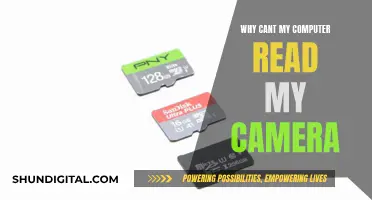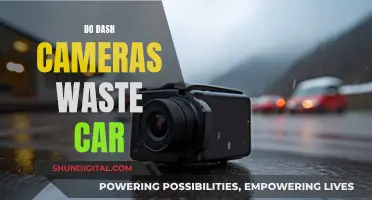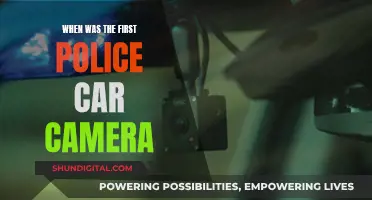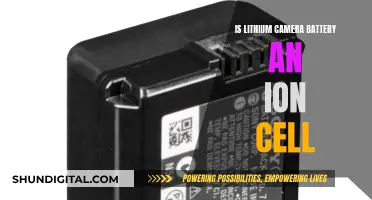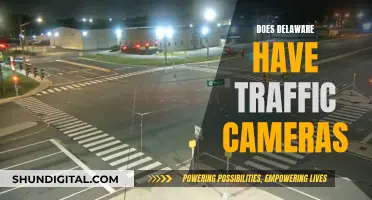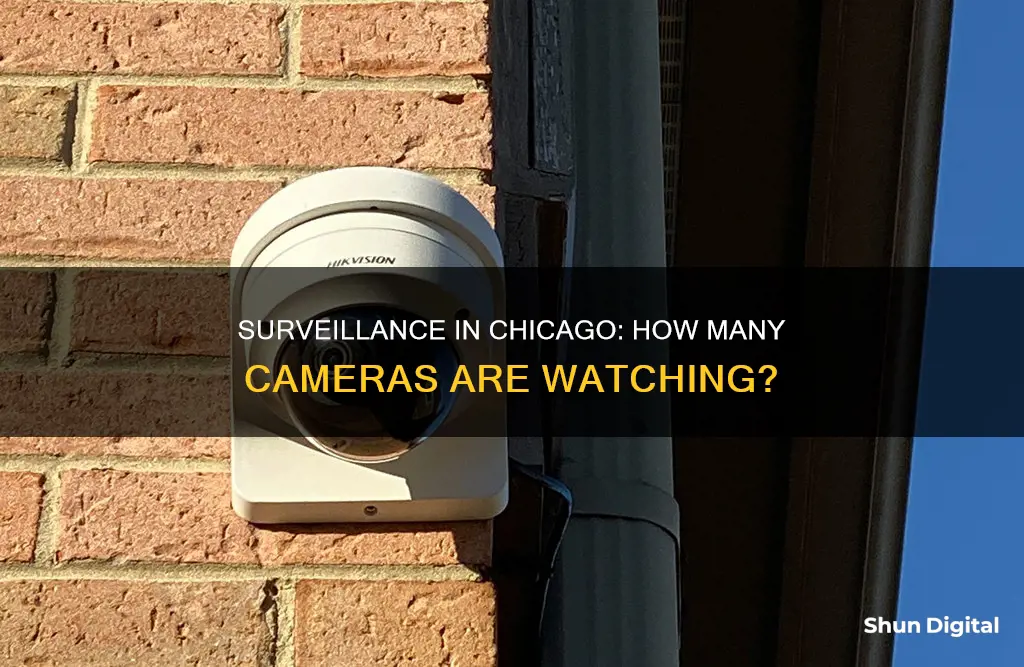
Chicago has a vast and growing surveillance network, with estimates of the number of cameras in the city ranging from 30,000 to 50,000. The system, which includes cameras from the Chicago Police Department, the CTA, parks, private businesses, and residences, has raised privacy concerns due to its lack of regulation and public reporting. With its high resolution, remote access, and facial recognition technology, the network has sparked debates about the balance between public safety and privacy in one of America's most-watched cities.
| Characteristics | Values |
|---|---|
| Total number of surveillance cameras | 32,000 (some sources state over 50,000) |
| Number of cameras per 1,000 people | 11.88 |
| Cameras per square mile | 212.4 |
| Number of private cameras within the police force's network | 10,000 |
| Number of cameras with access to real-time crime centres | 48,283 |
What You'll Learn

Chicago has over 30,000 surveillance cameras
The use of surveillance cameras in Chicago is a controversial issue. The American Civil Liberties Union (ACLU) has criticised the city's extensive surveillance network, claiming that it poses an "unregulated threat to privacy". In a 2011 report, the ACLU called for a moratorium on the deployment of any more cameras until a comprehensive review of the system could be conducted. Despite this, the number of cameras in Chicago has continued to grow, and the city's camera system remains largely unregulated.
Chicago's surveillance camera system is operated by the Office of Emergency Management and Communications (OEMC) and includes thousands of cameras from the Chicago Police Department, as well as cameras from the Chicago Transit Authority, Chicago Park District, and private businesses and residences. The cameras are equipped with pan, tilt, and zoom functions, allowing police to track people from camera to camera and monitor activity inside cars and homes. The system also enables facial recognition technology and automatic tracking.
Proponents of the surveillance cameras argue that they have helped to reduce crime in Chicago. For example, during the "Operation Disruption" pilot program in 2003, the use of 30 Police Observation Device (POD) cameras in high-crime areas resulted in a 76% decrease in narcotic-related calls and a 17% decline in serious index crimes. However, critics argue that there is no experimental evidence to support the claim that the cameras have reduced crime, and that the presence of the cameras may actually infringe on the privacy and freedom of expression of Chicago residents.
Focus Stacking: Which Cameras Offer This Feature?
You may want to see also

Cameras are linked to the police department
Chicago has a large and extensive network of surveillance cameras, with estimates placing the number at over 30,000. The Chicago Police Department has direct access to thousands of these cameras, which are used to monitor and deter criminal activity.
The Police Observation Device (POD) cameras are one such example of the CPD's use of surveillance technology. PODs are remote-controlled, viewable cameras with zoom and 360-degree rotation capabilities, positioned in high-crime areas. These cameras are highly visible, with blue flashing lights, the trademark checkerboard markings of the CPD, and a large CPD logo, to deter crime and inform the public of police surveillance. PODs have been strategically placed in areas with high levels of gang and narcotics activity, with the aim of disrupting illegal operations and driving criminals out of business.
The use of PODs has proven to be an effective tool in the fight against gangs, guns, and drugs. During "Operation Disruption", a pilot program launched in 2003, the deployment of 30 PODs in high-crime areas resulted in a 76% decrease in narcotic-related calls, a 17% decline in serious index crimes, and a 46% reduction in non-index, quality-of-life crimes. The success of this program led to an expansion of the POD initiative, with the number of PODs increasing to 80 by December 2003.
The CPD has continued to upgrade and enhance the capabilities of these surveillance devices, introducing Phase II, III, and IV PODs, also known as Micro-PODs. These newer models have wireless capabilities, allowing transmission to multiple monitoring locations, including district stations, the Crime Prevention and Information Center (CPIC), and the City's Office of Emergency Management and Communications Center (OEMC). The Micro-PODs are smaller, less overt cameras that can be installed on rooftops and towers, providing a more discreet form of surveillance.
The CPD's access to and utilisation of surveillance cameras have raised concerns about privacy and regulation. The American Civil Liberties Union (ACLU) of Illinois has been particularly vocal about the need for privacy protections and transparency in the use of these cameras. Despite the expanding camera system, the Chicago City Council has not implemented any regulations or held hearings to address privacy concerns. The ACLU's report, "Chicago's Video Surveillance Cameras: A Pervasive and Unregulated Threat to Our Privacy", highlights the lack of meaningful limits on the use of these cameras, enabling officials to track individuals and invade personal spaces without proper authorisation or oversight.
While the use of surveillance cameras in Chicago has sparked debates about privacy and civil liberties, the CPD continues to rely on this technology as a tool to combat crime and enhance public safety.
Vivint Doorbell Camera: Where's the Battery?
You may want to see also

Cameras are used to monitor political meetings
Chicago has a large and growing surveillance camera system, with estimates of the number of cameras in the city ranging from 32,000 to over 48,000. This includes thousands of cameras under the control of the Chicago Police Department, as well as cameras from the CTA, parks system, private businesses, and residences. All of these cameras can be accessed in a command center of the Office of Emergency Management and Communications (OEMC).
The extensive surveillance network has raised concerns about privacy and a lack of regulation. In 2021, the ACLU of Illinois issued a report calling for a moratorium on the deployment of any further cameras until a comprehensive review of the system, its reach, costs, and impact on privacy could be conducted. The report highlighted the lack of privacy regulations and the ability of police to track people from camera to camera, look inside cars and homes, and enable facial recognition technology.
The use of cameras to monitor political meetings can be a contentious issue, with potential benefits and drawbacks. On the one hand, cameras can be used to increase transparency and monitor safety at political meetings. They can also prevent political persecution and ensure the secrecy of the ballot, which is a universal right. However, the use of cameras can also intimidate voters and compromise the secrecy of the ballot, especially if their use is unregulated. Additionally, the cost of installing and maintaining cameras can be high, and there may be restricted access to footage for those who wish to review it.
In the context of Chicago's surveillance camera system, the use of cameras to monitor political meetings could be seen as an extension of the existing network. It would allow authorities to monitor political gatherings, track individuals, and potentially identify participants. However, without proper regulations in place, there are risks of privacy invasions, unauthorized access to footage, and potential misuse of the technology.
To ensure the appropriate use of cameras in monitoring political meetings, several criteria should be considered. Firstly, the decision to use cameras should be well-considered, agreed upon by all stakeholders, and supported by voters. The use of cameras should also be regulated by legislation, and the equipment procurement process should be transparent and accountable. Additionally, measures should be taken to protect the secrecy of the ballot and the privacy of individuals. This includes ensuring that cameras are positioned in a way that does not compromise the ballot's secrecy and establishing clear procedures for obtaining and using video footage.
In summary, cameras can be a useful tool for monitoring political meetings, but their use must be carefully considered and regulated to balance transparency and safety with the need to protect individual privacy and the secrecy of the ballot.
Cameras: Capturing Moments, Freezing Time, and Preserving Memories
You may want to see also

Cameras are accessible from a central command centre
Chicago has a vast surveillance system, with estimates of the number of cameras in the city ranging from 30,000 to 50,000. These cameras are accessible from a central command centre—the Office of Emergency Management and Communications (OEMC). This centralisation of surveillance means that, for example, a person walking north on Michigan Avenue from Roosevelt Road to Oak Street will remain in view of a camera for the entire duration of their walk.
The cameras in Chicago are operated by the Office of Emergency Management (OEM) and are purchased by the city, costing between $12,000 and $29,000 each. The city has thousands of cameras, putting the cost of the system in the tens of millions of taxpayer dollars. The cameras are known as "blue light" cameras, due to the flashing bright blue light on the older cameras operated by the Chicago Police Department (CPD). These older cameras also feature the logo of the CPD, while newer cameras are nondescript and blend into the environment.
The cameras are accessible from the OEMC through the Private Sector Camera Initiative, which allows private cameras from Chicago businesses and sister agencies to be accessed by the city. The Chicago Police Department also has access to the cameras, which are integrated into their crime-fighting initiatives. The CPD can manipulate the cameras from remote locations through the use of a portable terminal equipped with a monitor and joystick, allowing officers to pan 360 degrees and zoom in on specific types of public criminal activity.
The centralisation of the camera system in Chicago has raised privacy concerns. While the cameras are intended to capture people moving in public spaces, there are worries that they may also capture Chicago residents attending political meetings, religious events, or medical appointments. There are also concerns about the lack of clear privacy policies governing the collection and storage of footage, as well as the potential for abuse by camera operators who may use the cameras to monitor and track residents without a legitimate reason.
Finding the Remaining Battery Life on Your Canon SX10 IS
You may want to see also

Cameras can be privately owned
Chicago's surveillance system includes both private and public cameras. In 2011, the ACLU of Illinois issued a report expressing concerns about the city's extensive surveillance camera system, which at the time linked around 10,000 private and public cameras. Since then, the number of cameras has grown significantly, with estimates placing the current number at over 30,000. This includes cameras from private businesses and residences in various neighbourhoods. These private cameras are integrated into the city's surveillance network and can be accessed by law enforcement through a central command centre, raising concerns about privacy and a lack of regulation.
The integration of private cameras into the city's surveillance system is part of a broader trend in the United States, where police departments are encouraging businesses and homeowners to add their private cameras to law enforcement databases. This provides real-time access to footage for police officers, potentially enhancing their ability to respond to crimes and emergencies. However, it also raises concerns about the lack of privacy protections and the potential for abuse.
In Chicago, the surveillance camera system is operated by the Office of Emergency Management and Communications (OEMC). The OEMC has access to thousands of cameras from various sources, including the Chicago Police Department, the CTA, and the parks system. The OEMC's command centre allows law enforcement to track individuals across the city and monitor activities in real time. This level of surveillance has sparked debates about the balance between public safety and privacy rights.
While some argue that the extensive surveillance system can help solve Chicago's crime problem and improve response times, others worry about the lack of transparency and regulation surrounding its use. The ACLU of Illinois, for example, has called for a moratorium on the deployment of additional cameras until a comprehensive review of the system's impact on privacy can be conducted. They argue that the city has failed to implement meaningful privacy protections, even as the number of cameras and their capabilities have increased.
The debate around privately owned surveillance cameras in Chicago highlights the complex issues surrounding public safety and individual privacy rights. As technology advances and becomes more accessible, the integration of private cameras into government surveillance systems is likely to become more common. Finding a balance between utilising these tools for public safety and protecting the privacy and civil liberties of citizens will be a continuing challenge for cities like Chicago.
Vivint Camera Deter Mode: How Does It Work?
You may want to see also
Frequently asked questions
There are at least 30,000 surveillance cameras in Chicago, with some estimates putting the number at over 50,000.
The cameras are operated by Chicago's Office of Emergency Management (OEMC) and the Chicago Police Department (CPD).
There are concerns about privacy and the lack of regulation. The American Civil Liberties Union (ACLU) has called for a moratorium on the deployment of any more cameras until a comprehensive review of the system is conducted.
The Chicago Police Department first introduced video surveillance in 2003, with the aim of reducing crime in high-risk areas. The program was expanded in 2004 and again in 2005 and 2006, with the introduction of more sophisticated camera technology.


